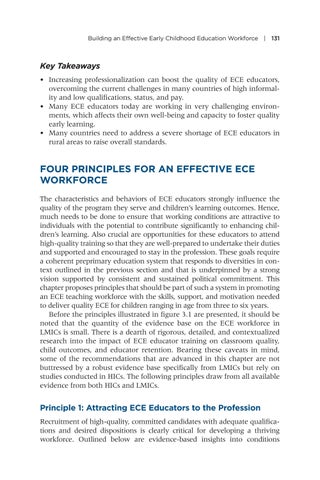Building an Effective Early Childhood Education Workforce | 131
Key Takeaways • Increasing professionalization can boost the quality of ECE educators, overcoming the current challenges in many countries of high informality and low qualifications, status, and pay. • Many ECE educators today are working in very challenging environments, which affects their own well-being and capacity to foster quality early learning. • Many countries need to address a severe shortage of ECE educators in rural areas to raise overall standards.
FOUR PRINCIPLES FOR AN EFFECTIVE ECE WORKFORCE The characteristics and behaviors of ECE educators strongly influence the quality of the program they serve and children’s learning outcomes. Hence, much needs to be done to ensure that working conditions are attractive to individuals with the potential to contribute significantly to enhancing children’s learning. Also crucial are opportunities for these educators to attend high-quality training so that they are well-prepared to undertake their duties and supported and encouraged to stay in the profession. These goals require a coherent preprimary education system that responds to diversities in context outlined in the previous section and that is underpinned by a strong vision supported by consistent and sustained political commitment. This chapter proposes principles that should be part of such a system in promoting an ECE teaching workforce with the skills, support, and motivation needed to deliver quality ECE for children ranging in age from three to six years. Before the principles illustrated in figure 3.1 are presented, it should be noted that the quantity of the evidence base on the ECE workforce in LMICs is small. There is a dearth of rigorous, detailed, and contextualized research into the impact of ECE educator training on classroom quality, child outcomes, and educator retention. Bearing these caveats in mind, some of the recommendations that are advanced in this chapter are not buttressed by a robust evidence base specifically from LMICs but rely on studies conducted in HICs. The following principles draw from all available evidence from both HICs and LMICs.
Principle 1: Attracting ECE Educators to the Profession Recruitment of high-quality, committed candidates with adequate qualifications and desired dispositions is clearly critical for developing a thriving workforce. Outlined below are evidence-based insights into conditions




